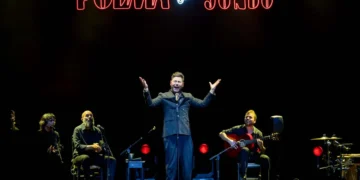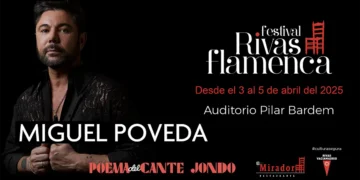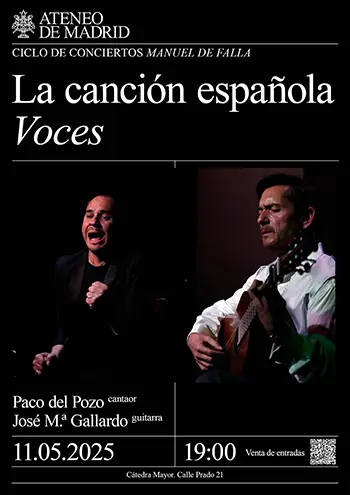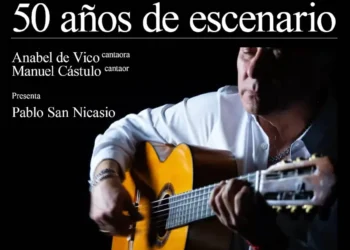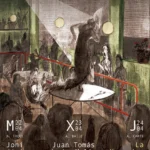|
Miguel Poveda
|
||||||
|
Cante: Miguel Poveda. Chorus and palmas: El Londro, Luis Cantarote, Carlos Grilo, Joaquina Amaya, Ana María González. Guitar: José Quevedo “El Bolita”, Jesús Guerrero, Diego del Morao, Manuel Parrilla. Dance: “La Lupi”. Percussion: Antonio Coronel, Paquito González. Guest artists: Jesús Méndez, Joaquín Grilo. IMPORTANT HAPPENINGS IN THE JEREZ BULL-RING Miguel Poveda has paid his dues in Jerez many times over. Long ago he won the unconditional admiration of nearly all the flamenco fans in this tough, strongly chauvinistic town. And it’s not only the diehard flamenco fans, but the general public as well. On Saturday night, when the man from Catalonia came to the Jerez bullring to present “ArteSano”, his most recent recording, it was not a very flamenco crowd; middle-aged couples, young people, housewives, retired people…in these troubled economic times, this is the triumph of Miguel Poveda, to have been able to break free from the limited circle of flamenco without sacrificing his integrity, and the MP phenomenon only continues to grow exponentially. In fact, in more than fifty years I’ve been circulating in flamenco, Miguel’s extraordinary popularity has only been surpassed by that of Camarón, and there’s no sign of it letting up.
All things considered, to single-handedly take on the responsibility of credibly filling seats at this vast venue with a capacity of nearly ten-thousand, and with tickets at 25 and 35 euros apiece, is quite a challenge. At a quick glance, I’d say about one third of the bull-ring’s total capacity, between folding chairs down in the ring, and the surrounding cement bleachers, was occupied. Arriving at the venue, the long lines around the plaza looked like the typical crowds that gather for the Fiesta de la Bulería. “ArteSano” is daring work thanks to its very lack of experimentation; traditional flamenco singing accompanied by guitar is not an easy sell these days. The presentation got underway with a slick biographical promotional video of about ten minutes, and then don Miguel came on to a warm ovation. His recital began with soleá apolá, malagueña of Peñaranda which he has always interpreted with rondeña ending and alegrías with the dancing of Susana “La Lupi” whose intelligence and exhuberance are the perfect complement to Poveda’s perspective. Tientos de Pastora are followed by bulerías, and Miguel pronounces the first spoken syllables of the night to shout out “Diego del Morao!”. High-quality guitars for this show. In addition to Diego, there’s José Quevedo “Bolita”, Manuel Parrilla and Jesús Guerrero. The recording also features Manolo Sanlúcar and Paco de Lucía. Poveda’s voice and delivery inhabit a narrow zone between funky old-style flamenco and saccharine lyrical singing, while managing to avoid the excesses of either. Tasty bulerías de Cádiz with the famous verse “…we won’t even care about being hungry” (‘ni el hambre la vamos a sentir’), and Miguel interjects “21% ladies and gentlemen!”, a reference to the recently approved tax hike. The image of a very young Miguel with his beloved maestro Pencho Cros is projected on the backdrop to set the tone for mining cante, and before getting into some bulerías, the singer expresses his profound gratitude towards Jerez for the warmth and affection he has always been shown. Poveda’s voice and delivery inhabit a narrow zone between funky old-style flamenco and saccharine lyrical singing, while managing to avoid the excesses of either. But not even that feat would have been enough to reach the heights of popularity. He also possesses strong charisma, you want to believe everything he says, he talks to the most numerous audience as he would talk to a friend in his living-room, he knows how to put a show together, has unfailing good taste and a musical sense that goes way beyond the norm.
Lupi returns with a tribute to her hometown in the form of some original verdiales, and this is when certain unmistakable forms and poses remind you she was Rocío Molina’s teacher for many years. After singing siguiriyas, Miguel had some introductory words for tangos de Triana. He expressed his consternation at the historic evacuation of Triana’s gypsy quarter which caused great cultural harm. This singer always has something to teach us or to defend, but without being heavy-handed about it. It’s yet another element of his personality: the genuine sense of humanity. A brilliant guitar solo of bulerías by Parrilla, and Miguel returns with fandango por soleá and some beautiful sevillanas danced by Lupi. “Long live Manolo Sanlúcar and Paco de Lucía!”, the latter being the guitarist on “ArteSano” who accompanies the alegrías now interpreted by Poveda. “Nanas” with the interpretive dancing of Lupi, and then, bulerías de Jerez with projected images of the monument to Paquera. Miguel summons Jesús Méndez to the stage to sing, and Trianita, the small grand-daughter of guitarist Niño Jero, to dance her charming bulerías bit and thoroughly win over the audience. Two hours of recital so far, and that was only the first part. The rest of the show was devoted to Spanish lyrical singing known as “copla”, with the piano accompaniment of Joan Albert Amargós. The flamenco crew returned for a closing fiesta finale with the participation of Joaquín Grilo, and Miguel not only showed no visible signs of fatigue at this point, but delivered more and more, doing that elegant dancing of his, artfully incorporating the familiar “festero” gesture” of pulling his jacket back to expose a shoulder. Three hours non-stop…hats off and three cheers for Miguel Poveda, highest honors for the man from Catalonia who came to Andalusia, to Jerez de la Frontera no less, to give us flamenco all nicely wrapped-up and ready to enjoy.
|








